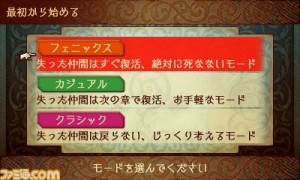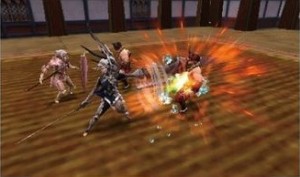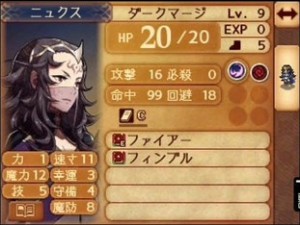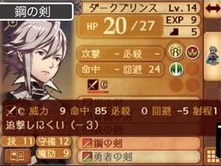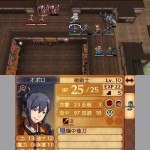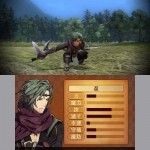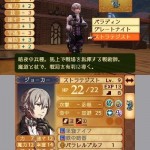So those sneaky Famitsu editors didn’t actually post the complete interview with the Fire Emblem if development team in their 14th May issue; instead, saving it to put on their website now.
Of course, if you missed the details from before, be sure to check the linked news post, as well as Kirokan‘s translated version of the interview.
As before, the interview begins with the concept behind the new game, which we already learned was built around this game’s main character–the Avatar and how his/her fateful choice impacts the story, splitting it into two distinct “what if” stories.
Because the Avatar is the main character, the game’s movie scenes are now typically observed from a first-person (the Avatar’s) perspective. No doubt, you’ve probably already seen a number of scenes in the trailers that showcase this.
In Awakening, the first-person perspective was used on a few occasions, but most of the time the movies centred around Chrom, because the Avatar mainly had a support role back then.
Next, the developers go on to explain the reasoning behind the radical Phoenix Mode–the mode where fallen characters are resurrected on the next turn. (Which I won’t repeat to save space and sanity.)
An amusing comment: Although it sounds like you cannot lose on this mode, there are times when you still have to play somewhat carefully.
Especially during the Nohr campaign, when there may be complicated victory conditions, such as reaching a destination within a certain number of turns. If you fail these conditions, you can still get a Game Over, of course!
After this, the interview is mostly the same as before, until we reach a brief discussion about Attack Stance and Guard Stance, which is the new version of Awakening’s Dual and Pair Up systems.
Right now, we don’t have all the information regarding Attack Stance and Guard Stance, but we now know they have a 100% activation rate when “conditions have been met”. This is the same case for enemies.
Naturally, Attack Stance (where fighting adjacent to an ally allows for that ally to perform a follow-up attack) is fantastic for improving your damage output, but it doesn’t really help your units when enemies decide to gang up on them (with their own Attack Stance, for instance).
To withstand the onslaught of several enemies, it might often be wiser to adopt a Guard Stance (where two allies combine into one and one of the allies can deflect enemy attacks). Basically, players are encouraged to adopt different stances according to the given situation.
Right after this, Famitsu asks if the developers can share any information of interest to fans and they begin talking about the abolishing of weapon durability.
Maeda explains that when development started on the new game, one of the major challenges was to find ways to help newcomers enjoy the game without feeling too stressful.
One thing that came to mind was the timing of when to use valuable weapons (eg. saving them for a future mission), and it was perceived that this form of intense micro-management was too much for newcomers to properly enjoy.
Since some players may consider it wasteful to use a particular weapon, they may end up not using it at all; at which point it’s as if the weapon doesn’t exist.
By removing the durability of weapons and giving them more interesting properties, it allows for more enjoyable play, without detracting from the fun of picking weapons.
We already know that weapon Weight isn’t in, but Higuchi states that there are “strong weapons that are harder to double attack with” (presumably like the Steel Sword), which functions a bit like it.
Interestingly, Javelins and similar ranged weapons (such as Hand Axes, most likely, and not naturally ranged weapons like Tomes or Hidden Weapons) can no longer double attack.
Moving on, Famitsu asks why it was decided for Yusuke Kozaki to retain his role as character designer from Awakening. When this topic was brought up at the start of development, it seems the staff unanimously agreed on bringing back Mr. Kozaki.
In fact, since the new game has more characters than even Awakening (likely because of the two campaigns in one), there were worries if Yusuke Kozaki would accept the offer or not, so the team were very glad when he agreed to reprise the role again.
Finally, a tiny bit on the story.
Unlike previous games in the series, this game takes place in a “completely new world”, although there are familiar elements that are sure to bring a smile to those who have played Awakening.
As we’ve seen, Hoshido is based on ancient Japanese culture, while Nohr is built on the series’s traditional Western fantasy setting.
While Nohr is Western-themed, it also carries a dark atmosphere; its castle even stands in the middle of a giant hole in the ground. So there’s a feeling it’s not your typical Western fantasy nation.
In terms of the setting, Hoshido is a pacifist kingdom with exceptional peace and order. In contrast, Nohr is subject to terrible weather conditions, leading to poor crop yields and a lack of law and order. In order to expand Nohr’s influence, King Garon orders his children to invade Hoshido.
Thus the royal siblings fight for Nohr, although they each harbour their own hidden thoughts. Meanwhile the Hoshidan royals take up arms to repel the Nohrian invasion. As this happens, the hero–the Avatar–is stuck in between and forced to make a difficult choice…
At the end, Famitsu inquires about the different classes that feature in each campaign.
It seems that the classes available largely depend on the campaign chosen. So in Nohr, you will typically see more characters in familiar classes, like Cavaliers. While in Hoshido, most of the characters are in Japanese-themed classes, like Samurais.
The weapons you can obtain depend on the campaign too. For example, in Nohr, you will commonly obtain “swords”, while in Hoshido you are more likely to find “katanas”, which have slightly different properties.
Although Pegasus Knights have been in the series so far, they technically do not exist in this game. Instead we have Hoshido’s very similar “Pegasus Warrior” class.
But unlike the female-only Pegasus Knights of yore, these Pegasus Warriors can be male or female. After promoting, they can wield Bows in addition to Lances.
Correction: Pegasus Warrior is not a promoted class. I didn’t take into account that “Class Change” can refer to reclassing and not just promoting.
Now that’s all for the interview itself, but there are a few new screenshots we haven’t seen before, which reveal some new and interesting things…
The most important one has Joker the Butler about to use a new Parallel Seal to reclass into a Paladin, Great Knight or Strategist. The Strategist–not to be confused with the similarly named Tactician–is a horseback unit that wields Tomes and Staves (likely a promoted Rod Knight).
Besides what we can physically see, this image has further implications.
One, Joker’s Level is not 1 in the bottom screen (which acts as a preview of the completed reclass), suggesting Parallel Seals, unlike Second Seals, do not reset the unit’s Level afterwards. Whether Second Seals (or a similar item that does reset Level) exists or not is currently unknown.
Two, it seems characters may have only two class branches, unlike the three they had in Awakening. Right now, it’s likely Joker has access to the Cavalier and Rod Knight branches, which promote to Paladin or Great Knight and Strategist or Butler/Maid respectively.
As always, you’re welcome to join us as we feverishly break down and discuss the interview on the forums!

